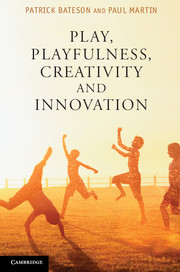Book contents
- Frontmatter
- Contents
- Advance praise
- Preface
- Acknowledgements
- 1 Introduction
- 2 The biology of play
- 3 The functions of play
- 4 Evolution and play
- 5 Creativity in humans
- 6 Animals finding novel solutions
- 7 People and organisations
- 8 Childhood play and creativity
- 9 Humour and playfulness
- 10 Dreams, drugs and creativity
- 11 Pulling the threads together
- Notes
- References
- Index
6 - Animals finding novel solutions
Published online by Cambridge University Press: 05 July 2013
- Frontmatter
- Contents
- Advance praise
- Preface
- Acknowledgements
- 1 Introduction
- 2 The biology of play
- 3 The functions of play
- 4 Evolution and play
- 5 Creativity in humans
- 6 Animals finding novel solutions
- 7 People and organisations
- 8 Childhood play and creativity
- 9 Humour and playfulness
- 10 Dreams, drugs and creativity
- 11 Pulling the threads together
- Notes
- References
- Index
Summary
In this chapter we develop the idea that some of the more interesting cognitive abilities of complicated animals derive from playful experiences earlier in their lives. We freely admit that much of what we propose is speculative and the abilities may also arise in other ways. We begin with a well-known story. In one of Aesop’s fables, a crow – half-dead with thirst – came upon a pitcher but found only a little water in it. He could not reach far enough down with his beak to get at the water. After many attempts, he took a pebble and dropped it into the pitcher. He went on dropping in pebbles, raising the water level a little at a time, until at last he was able to reach the water.
The fable has become a reality, not with a crow but another member of the crow family, the rook (Bird & Emery, 2009). In the rook’s case the prize was a mealworm lying on the surface of the water in a transparent plastic tube. The rook could not reach the mealworm with its beak but, just as in Aesop’s fable, when given a pile of pebbles, the bird dropped them into the water one by one until it had raised the water level enough and could reach the mealworm. The experiment was extended using two Eurasian jays, which are also members of the crow family (Cheke, Bird & Clayton, 2011). The birds were given piles of two different types of object that could be dropped into the water. One pile consisted of pebbles and the other was pieces of cork the same size as the pebbles. The jays quickly learnt to discriminate between the pebbles, which raised the water level, and the corks, which floated on top and did nothing to raise the level. They too used the pebbles to obtain the food. In both cases, the birds appeared to understand and then solve a practical problem with speed and insight, rather than relying on laborious trial and error.
- Type
- Chapter
- Information
- Play, Playfulness, Creativity and Innovation , pp. 69 - 76Publisher: Cambridge University PressPrint publication year: 2013



